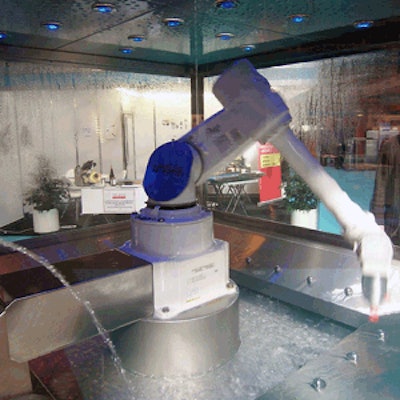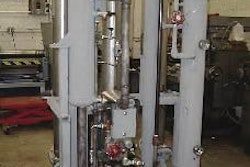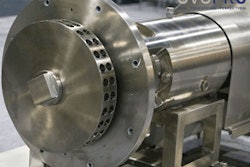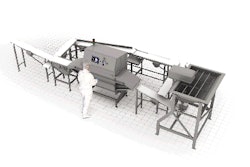
Automation in the poultry processing plant is taking further steps to address the constant challenge of avoiding contamination. Both at the research level and in commercial practice, the first examples have appeared of a generation of robots that are made to be clean in a food environment.
Go back about 10 years and the automated systems of the time had been developed more for making cars than for handling foods. Although solid and reliable in performing repetitive tasks, the robotics could hardly be called food-standard with their oily gearboxes and spray-painted metalwork. Where hygiene was demanded, the only solution seemed to be to encase the most sensitive section of the machinery in a cleanable jacket.
Over the last five years, however, the manufacturers of robots in Asia and in Europe have turned their attention to the specific needs of the food processor in order to compensate for a slowdown in repeat orders from the vehicle makers. This means, first and foremost, doing something positive about hygiene. A recent report from the Georgia Tech Research Institute in the USA makes clear that the researchers also recognise the case for cleanability in food-processing automation.
Washable robot packs meat
The GTRI account refers to a project led by research engineer Jonathan Holmes in the institute's division of food processing technology. Working in association with US automation company CAMotion Inc and meat processor Cargill Meat Solutions, the project's aim had been to develop a machine that was capable of being washed continually. The machine would pack fresh meat into trays, said the report, but with a design and construction able to withstand routine washing by means of a high-pressure water spray and exposure to corrosive sanitising chemicals.
The team looked in particular at the robotics involved in taking meat products from a conveyor at a rate of one per second and placing them on foam packaging trays. While the automating process was a relatively straightforward application of existing technological know-how, the more difficult part was to find appropriate components to secure washability.
A prototype has been produced with special protective coatings and plating on its metal parts. There are also shaft seals on its motors and other moving parts.
It also has special watertight bearings that are little affected by the washing down of the machine at regular intervals.
Increasingly stringent standards
Meanwhile, a European specialist in supplying robotics has emphasised the increasingly stringent requirements placed on the food industry for ensuring cleanliness. With the potential hygiene-related costs from product loss, contamination and food safety fears, said Sweden-based ABB Automation Technologies, hygiene has become an ever higher priority for companies working with food and beverages.
An indication of the link to the industry's ever-rising adoption of automated handling lies in the increased number of regulations and standards regarding the hygienic design of machinery for packaging and processing of food products.
The European Hygienic Engineering & Design Group (EHEDG) has published many best practice guidelines and recommendations to help comply with all of these standards.
One fundamental European regulation is the EU Machinery Directive 98/37/EC. This requires that machinery suppliers meet certain essential hygiene requirements for the handling of foodstuffs. Within this directive, ABB points out, there is a general standard that sets out the requirements regarding risks to hygiene arising from the use of machinery and processes.
High-speed washdown robots have been produced to go with hygienic pick-and-pack systems, it continues.
They answer the possible perception that robots may be inappropriate for food or pharmaceutical applications where hygienic washdown is required.
ABB's own FlexPicker robot is cited as a specific example to meet packaging applications with open food such as meat, because a washdown version in stainless steel is now available. This features a special paint finish, corrosion-resistant material, sealed components and a fourth axis with slide bearings for easy cleaning using detergents.
Designs aimed at food processing
The first use of such machines in chicken plants is said to be imminent in western Europe, but interest in the whole idea of washability with robots was already raised this year at the Meatex exhibition in the UK. Its displays included a fully washable robot launched within the past 18 months by the world's largest manufacturer of robotic systems.
The exhibit by the British distributor for Fanuc of Japan took the form of a perspex case around a robotic arm that was washed constantly by jets of water from each side.
The design of the machine has been aimed specifically at food industry applications. Its developers explained that, to be totally washable, its arm sections have been moulded from plastic with no metal parts and it also has plastic drive bearings. Smooth lines to the outside avoid so-called bug traps. No oil lubrication occurs in any bits of the arm that would come close to the product being packaged.
Today, the main tasks between slaughter and further processing are highly automated in many chicken plants. But there may yet be possibilities for reducing the manual labour used to place live birds on shackles, according to the company, and even more for replacing much of the work done manually at present in picking up fillets or drumsticks and placing them neatly in a retail pack. The advent of the fully washable clean machine brings that opportunity closer, by answering the worries over hygiene.
















